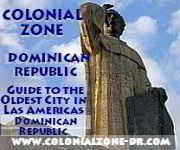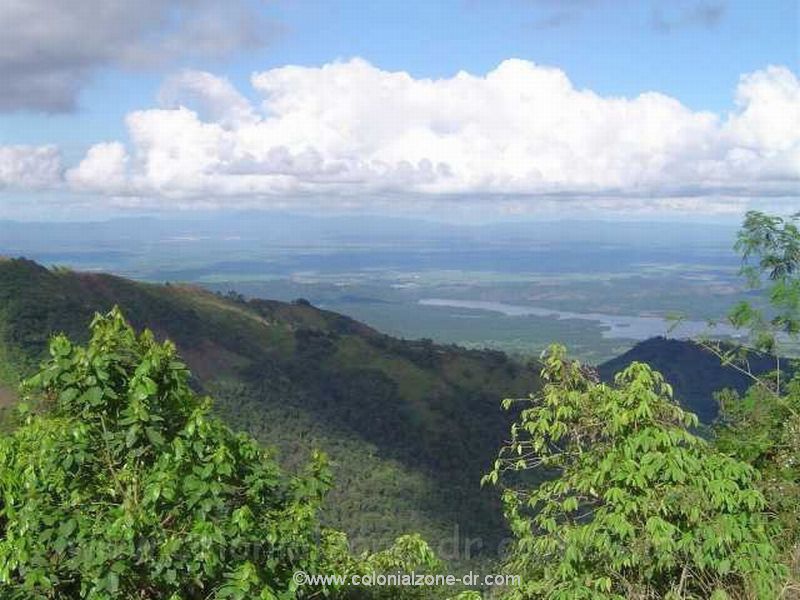If you found my web site useful consider making a donation through Pay Pal.
Thanks!

|
|

Custom Search
Gracias a coinmill.com


Dominican Republic Protected Areas and Invironmental Issues
Home | Dining & Night Life | Hotel | Sights | Pictures | Music | Colonial Zone Map | Hot Spots! Directory | Site Search
site map Copyright © 2005 - 2016 All Rights Reserved. Colonial Zone-Dominican Republic (DR)
Our complete exchange rate tool.
Home | Calendar | Night Life/Dining | Sight Seeing | Pictures | Businesses | Artists | Food | Helps | History | Language | Music | Media | Pastimes | Products | Tradition/Legend | Links | About Us | Buy Mamajuana | News Blog | DR Gringa's Life Blog | Dominican Dog Blog | Web Designer
[TOP]
Important Stuff - Environmental Issues
Important Stuff | Important Emergency phone numbers - Telephone and Internet Services | Flag, Shield and National Symbols | Dominican Republic Facts | Environmental Issues | National Parks & Reserves | National Songs | Religious Beliefs | Charities | Creatures | Trivia and Useless Facts | Live Cameras/ Camaras en Vivo | Public Services | Travel - Flight Information |
Protected Areas/ Environmental Issues
About Protected Areas | Did You Know? | List of National Parks | Details of National Parks and Reserves
+click image to enlarge
The valleys and mountains in Dominican Republic.
According to the official tally, there are 118 protected areas, but of these only 59 are well managed. We have an important number of sites which include 16 national parks, nine natural monuments and six scientific reserves. These sites include panoramic routes, recreational areas and ecological corridors, all of which are under the direct supervision and control of the Dirección Nacional de Parques (the National Parks Office).
November 2012, the Government of the Dominican Republic added 31 new protected areas into its national protected areas system by an unprecedented Presidential Decree. The new protected areas encompass a total of 1,321,024 hectares — a little more than 3.2 million acres — of terrestrial and marine habitat.
There are six categories of protected areas in the country.
1. Strict Protection Areas (scientific reserve, biological, marine sanctuary)
2. National Parks
3. Natural and Cultural Monuments
4. Habitat Management Areas
5. Nature Reserves (forest reserves, forest model)
6. Protected Landscapes (via panoramic, ecological corridor and recreational areas)
Dominican Republic is becoming more conscious of the environment and they have put forth laws to protect it. We are one of the most biologically diverse countries in the Caribbean
Of all the protected areas we have in Dominican Republic it is found that only 59 follow the guidelines established by the International Union for the Conservation of Nature (IUCN).
The pine forests on the mountains of the Cordillera Central are the only remaining extensive forest in the country. This is because two-thirds of the virgin forests have been destroyed since the discovery of the island by Columbus. The protection of these parks has controlled the complete disappearance of the forests that was predicted to happen in the 1990's.
A study has found that tourist-oriented activities do not give the proper importance to environmental concerns, and that uncontrolled visits by hundreds of people greatly disrupt the internal micro-climates and the bat population. Likewise, motorboats contribute to spoil the beach areas with fuel and lubricants that affect the habitat of manatees, dolphins, turtles and iguanas and pollute the waters.
+click to enlarge
Aerial view of the mountains of Cordillera Central
So please, when you are on our beautiful island, respect the environment even if those around you do not seem to care. We want to preserve the habitat for future generations to enjoy.
In 1996, President Balaguer created new protected areas that are now off-limits for hotel or housing construction. National parks were established in Lago Enriquillo. Bahía de Calderas is now a national monument created to protect the ecosystem in the dunes of Las Salinas, the largest sand dunes in the Caribbean. Bahía de Luperón in Puerto Plata and Cascada del Limón in Samaná are also national monuments. Laguna Rincón in the East is has become a protected wildlife area which also has the anthropological reserve of las Cuevas de las Maravillas. Boca de Soco, which runs 15 km along the San Pedro de Macorís road on the way to La Romana where several panoramic roads were created along scenic routes. El Puerto, Guaigui, Playa Andres, Boca Chica and Cayo Levantado are designated national recreation areas.
The Dominican Republic has many animal and bird species only found on our island. We have become a popular bird watching destination. We have several types of parrots, hummingbirds, the guaraguao (a hawk), barrancolí and the flautero. Mammals on the island include the hutia, an endangered, endemic rodent, the also endangered manatee whose habitat is located in Estero Hondo. More information and pictures of some of thes animals - Creatures of Dominican Republic.
Did you know?
*There are more than 200 caves in the Dominican Republic's Parque Nacional del Este and many are decorated with pre-Columbian pictographs of the Taino people.
*The waters and lands of the Caribbean Islands provide habitat for six of the world's seven turtle species and 14 percent of the world's coral reefs.
*There are some 5,600 plant species, 20 land mammal species and 303 bird species that are found in Dominican Republic. To learn more about this and about what The Nature Conservancy is doing to help protect some of our diverse, wonderful island.
+click to enlarge
Taino cave drawings
National Parks in Dominican Republic Armando Bermúdez, Cabo Francés Viejo, Cueva de las Maravillas, Del Este, El Choco, Estero Hondo, Isla Cabritos, Jaragua, José del Carmen Ramírez, Juan Pablo Duarte, Julio Cicero M., La Caleta, La Gran Laguna, La Isabela, La Vega Vieja, Lago Enriquillo, Laguna de Cabral o Rincón, Lagunas Bavaro y Caletan, Litoral Norte de Puerto Plata, Litoral Sur de Santo Domingo, Loma Guaconejo, Los Haitises, Montana La Humeadora, Monte Cristi, Nalga de Maco, Parque Submarino La Caleta, Sierra de Bahoruco, Sierra de Martin Garcia, Sierra de Neiba
Natural Monuments in Dominican República Bahía Maimón, Donald y Annabelle Dod, Dunas de las Calderas, Las Caobas
Natural and Scientific Reserves in Dominican Republic Isabel de Torres, Lagunas Redonda y Limón, Valle Nuevo, Isla Catalina, Villa Elisa (Dr Orlando Cruz Franco)
Protected Lands in Dominican Republic Carretera Barahona-Enriquillo, Cinturón Verde de Santo Domingo, Idelisa Bonnelly de Calventy, Luis Ariza Julia, Sur de Santo Domingo
Strict Nature Reserve in Dominican Republic Ebano Verde, Quita Espuela
Whale Sanctuary in Dominican Republic Banco de la Plata
Other Area in Dominican Republic Bahoruco Oriental, Cabo Engaño, Casabito, Costa del Este, Cruz Verde, Jaiqui picado, Lagunas Cabarette y Goleta, Las Dunas de Baní, Loma Barbacoa, Loma Diego de Ocampo, Loma la Herradura, Playa Chiquita de Azua (Costa Sur), Rió Comate/ Rió Comatillo (Bayaguana), Yuvita
I have written more detailed information about National Parks and Reserves of Dominican Republic with a map.
(top)Valle Nuevo Reserva Cienifica
+click images to enlkarge
(bottom) Lago Enriquillo
I have written more detailed information about National Parks and Reserves of Dominican Republic with a map.
Center for the Conservation and Eco-Development of Samaná Bay and its Surroundings (CEBSE)
This National Geographic site has some interesting environmental facts on Dominican Republic. We want to preserve our Island for future generations.
[TOP]









